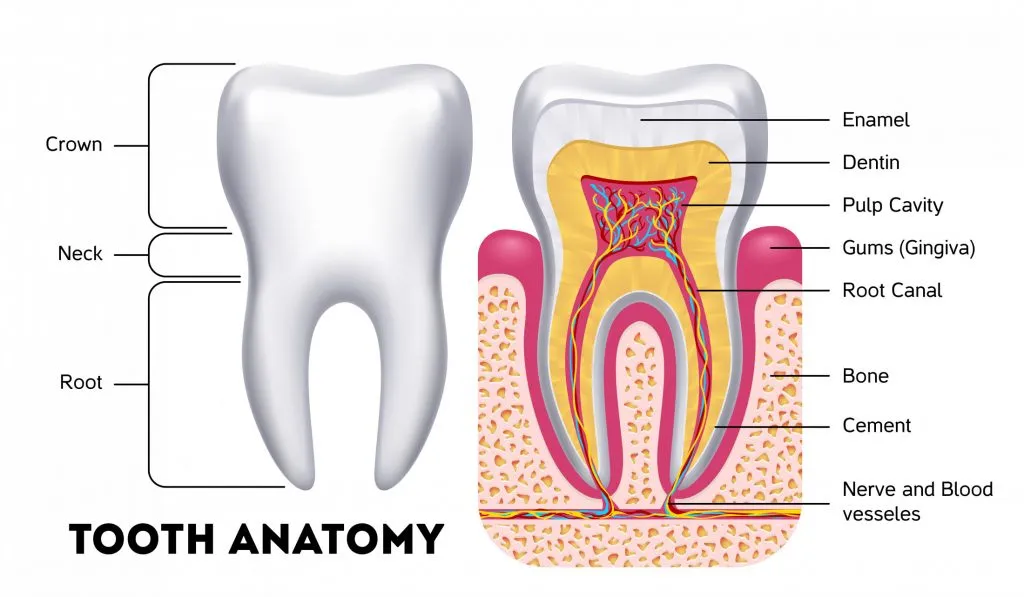Accessory Organs of the Alimentary Canal
Digestive Organs Other than the intestines and the stomach, the following are also part of the digestive system:
Teeth
The role the teeth play in food processing needs little introduction; we masticate, or chew, by opening and closing our jaws and moving them from side to side while continuously using our tongue to move the food between our teeth.
-
Function. The teeth tear and grind the food, breaking it down into smaller fragments.
-
Deciduous teeth. The first set of teeth is the deciduous teeth, also called baby teeth or milk teeth, and they begin to erupt around 6 months, and a baby has a full set (20 teeth) by the age of 2 years.
-
Permanent teeth. As the second set of teeth, the deeper permanent teeth, enlarge and develop, the roots of the milk teeth are reabsorbed, and between the ages of 6 to 12 years they loosen and fall out.
-
Incisors. The chisel-shaped incisors are adapted for cutting.
-
Canines. The fang like canines are for tearing and piercing.
-
Premolars and molars. Premolars (bicuspids) and molars have broad crowns with round cusps ( tips) and are best suited for grinding
-
Crown. The enamel-covered crown is the exposed part of the tooth above the gingiva or gum
-
Enamel. Enamel is the hardest substance in the body and is fairly brittle because it is heavily mineralized with calcium salts.
-
Root. The outer surface of the root is covered by a substance called cementum, which attaches the tooth to the periodontal membrane (ligament).
-
Dentin. Dentin, a bonelike material, underlies the enamel and forms the bulk of the tooth.
-
Pulp cavity. It surrounds a central pulp cavity, which contains a number of structures (connective tissue, blood vessels, and nerve fibers) collectively called the pulp.
-
Root canal. Where the pulp cavity extends into the root, it becomes the root canal, which provides a route for blood vessels, nerves, and other pulp structures to enter the pulp cavity of the tooth.

Salivary Glands
Three pairs of salivary glands empty their secretions into the mouth.
-
Parotid glands. The large parotid glands lie anterior to the ears and empty their secretions into the mouth.
-
Submandibular and sublingual glands. The submandibular and sublingual glands empty their secretions into the floor of the mouth through tiny ducts
-
Saliva. The product of the salivary glands, saliva, is a mixture of mucus and serous fluids.
-
Salivary amylase. The clear serous portion contains an enzyme, salivary amylase, in a bicarbonate-rich juice that begins the process of starch digestion in the mouth. Pancreas Only the pancreas produces enzymes that break down all categories of digestible foods.
-
Location. The pancreas is a soft, pink triangular gland that extends across the abdomen from the spleen to the duodenum; but most of the pancreas lies posterior to the parietal peritoneum, hence its location is referred to as retroperitoneal.
-
Pancreatic enzymes. The pancreatic enzymes are secreted into the duodenum in an alkaline fluid that neutralizes the acidic chyme coming in from the stomach.
-
Endocrine function. The pancreas also has an endocrine function; it produces hormones insulin and glucagon. Liver The liver is the largest gland in the body.
-
Location. Located under the diaphragm, more to the right side of the body, it overlies and almost completely covers the stomach.
-
Falciform ligament. The liver has four lobes and is suspended from the diaphragm and abdominal wall by a delicate mesentery cord, the falciform ligament.
-
Function. The liver’s digestive function is to produce bile.
-
Bile. Bile is a yellow-to-green, watery solution containing bile salts, bile pigments, cholesterol, phospholipids, and a variety of electrolytes.
-
Bile salts. Bile does not contain enzymes but its bile salts emulsify fats by physically breaking large fat globules into smaller ones, thus providing more surface area for the fat-digesting enzymes to work on.
Gallbladder
While in the gallbladder, bile is concentrated by the removal of water.
-
Location. The gallbladder is a small, thin-walled green sac that snuggles in a shallow fossa in the inferior surface of the liver.
-
Cystic duct. When food digestion is not occurring, bile backs up the cystic duct and enters the gallbladder to be stored.


